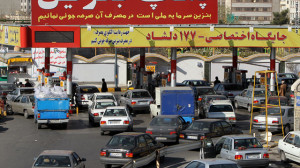January 31-2014

The Majlis Energy Committee has spent weeks debating what to do about Iran’s gasoline prices, which are still very low despite a commitment to boost them close to the world market price. But as Iran has raised the rial price, the erosion in the value of the rial has made gasoline progressively cheaper in market terms.
The price of gasoline today, in dollar terms, is 88 cents a gallon or barely half the price of $1.66 a gallon that was set six years ago. The government has only gotten further and further away from its declared goal of bringing the price in line with the international market.
Three deputies serving on the Majlis Energy Committee have been quoted by Shana, the Oil Ministry’s news service, as saying the committee hasn’t yet been able to make up its mind whether to raise gasoline prices at Now Ruz and, if so, to what level.
The comments by Deputies Hossain Dehdashti, Ali Marvi and Musa Ahmadi came after the head of the government’s Fuel Management Committee, Mojtaba Shafii, said the government has drafted three different proposals for gasoline.
The first would leave the current policy where it is now. Drivers can buy up to 60 liters (16 gallons) of gasoline a month for 4,000 rials a liter. That is 50 cents a US gallon. Any amount above 60 liters may be bought for 7,000 rials a liter, which is 88 cents a gallon.
The second plan would raise the price of unlimited volumes to 11,000 rials per liter or $1.40 per gallon. Shafii did not say what the price of the first 60 liters would be under this plan, which some took to mean there would no longer be a lower tier price and all sales would be at 11,000 rials.
The third plan, Shafii said, would raise the price to 18,000 rials per liter, a stunning overnight price hike of 157 percent. It is difficult to believe that any politician would agree to that for fear of the public reaction. The price at the current exchange rate would then be $2.27 per gallon, still a dramatically low price when compared to other countries.
Some analysts suggested there was a common ploy involved here, where three options are offered, one of which is impossibly low and one impossibly high, thereby driving decision-makers to the middle option.
By most published listings, Iran’s gasoline price is now the second lowest in the world, with only Venezuela’s even lower. The president of Venezuela recently said the gasoline price there would have to be raised, but he hasn’t announced any new price.
President Ali-Akbar Hashemi-Rafsanjani first said in the early 1990s that the country could not afford to continue heavily subsidized fuel prices and called for lifting the price each Now Ruz until it reached the free market level. He was able to get a price boost each Now Ruz for a few years. But the Majlis then lost interest and President Mohammad Khatami just ignored the issue during his eight years.
President Mahmud Ahmadi-nejad, like Rafsanjani, said the subsidies were killing the country economically and pushed for annual price hikes. He had the price raised from 800 rials a liter to 1,000 rials in May 2007, which was the equivalent of 41 cents a gallon then. In subsequent months, gasoline was rationed at that price and the second-tier of gasoline at 4,000 rials per liter above 120 liters a month was created at Now Ruz 2008. That was equal to $1.66 a gallon then.
Since then the price has been raised periodically and the number of liters sold at the cheap rate has been whittled down to today’s 60 liters.
